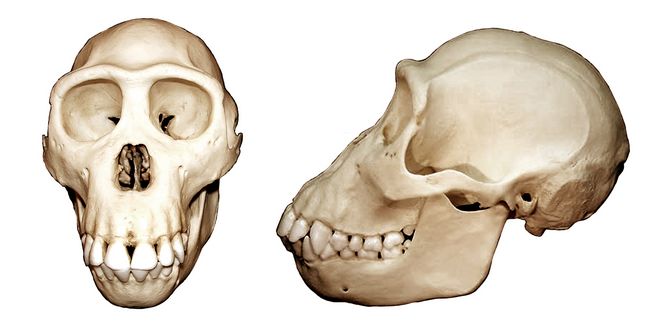Athena Review Image Archive ™
Bonobo chimpanzee (Pan paniscus) female skull

Skull of a female bonobo chimpanzee (Pan paniscus)
The bonobo chimpanzee (Pan Paniscus), also called the pygmy chimpanzee, is one of two species making up the genus Pan, along with the common chimpanzee (Pan troglodytes). The bonobo lives in a 500,000 km2 (190,000 sq mi) area of the Congo Basin in the Democratic Republic of the Congo, Central Africa. Bonobos are found only south of the Congo River and north of the Kasai River (a tributary of the Congo).
The species inhabits primary and secondary forests, including seasonally inundated swamp forests. The bonobo is an omnivorous frugivore, most of its diet being fruit supplemented with leaves, honey, eggs, and meat from small vertebrates. The bonobo, slightly smaller than the common chimp, has relatively long legs. Bonobos typically live 40 years in captivity. Their lifespan in the wild is unknown, but it is probably shorter.
The bonobo was first recognised as a distinct taxon by German anatomist Ernst Schwarz (1929), who classified the bonobo as a subspecies of chimp. A few years later, American anatomist Harold Coolidge (1933) elevated it to species status. American psychologist and primatologist Robert Yerkes was one of the first to notice major behavioural differences between the bonobo and the common chimp.
The bonobo genome was published in June 2012, based on a female bonobo from the Leipzig zoo. This confirmed that the bonobo genome is about 0.4% divergent from the chimpanzee genome. DNA evidence suggests the two species diverged about 890,000–860,000 years ago, due to physical separation of these two populations (Caswell et al 2008). Currently, these two species are separated by the Congo River. As the two species are not proficient swimmers, the formation of the Congo River in the early Pleistocene period 1.5–2.0 mya possibly led to their separation into two species. Bonobos live south of the river, and were presumably separated from the ancestors of the common chimpanzee who lived north of the river.
The first Pan fossils were reported in 2005 from the Middle Pleistocene (after the bonobo–chimp split) of Kenya, alongside early Homo fossils (McBrearty and Jablonski 2005).
Based on genetics, along with the common chimpanzee, the bonobo is the closest extant relative to humans. DNA comparison suggests continual interbreeding between ancestral Pan and Homo groups, post-divergence, until about 4 million years ago. According to Zihlman et al (1978), bonobo body proportions closely resemble those of Australopithecus.
Field observations have shown that common chimpanzee males are hostile to males from outside the community, attacking any single male outsiders and sometimes killing them. Based on significantly less observation in the wild, this does not appear to be the behavior of bonobo males or females. According to some anthropologists, human ancestors went through a bonobo-like phase featuring reduced aggression and associated anatomical changes, exemplified in Ardipithecus ramidus (Clark and Hennebert 2015).
References
Caswell J.L., S. Mallick , D.J. Richter 2008. In McVean, Gl (ed.). Analysis of Chimpanzee History Based on Genome Sequence Alignments. PLOS Genet. 4 (4)
.Clark, G. and M. Henneberg 2015. The life history of Ardipithecus ramidus: A heterochronic model of sexual and social maturation. Anthropological Review. 78 (2): 109–132.
Coolidge, H.J. 1933. Pan paniscus. Pigmy chimpanzee from south of the Congo river. American Journal of Physical Anthropology. 18 (1): 1–59. .
McBrearty, S. and N.G. Jablonski, 2005. First fossil chimpanzee. Nature. 437 (7055): 105–8.
Schwarz, E. 1929. Das Vorkommen des Schimpansen auf den linken Kongo-Ufer. Revue de Zoologie et de Botanique Africaines. 16: 425–426. .
Zihlman, AL, J.E. Cronin, D.L. Cramer,and V.M. Sarich, 1978. Pygmy chimpanzee as a possible prototype for the common ancestor of humans, chimpanzees and gorillas. Nature. 275 (5682): 744–6. :
Copyright © 1996-2020 Rust Family Foundation (All Rights Reserved).